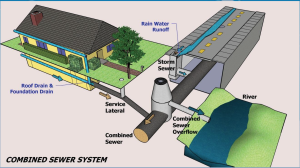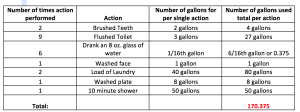1a.) In my hometown, the Municipal Water Authority collects and distributes water for seven different counties around the area. The water is collected from the surface water of the Allegheny river. Once at the plant, water at the purification plant is treated by coagulation, sedimentation, filtration, and disinfection. Then, it is further treated with fluoride, chlorine, and a corrosion inhibitor before being distributed to the consumer. From the treatment center, it is transferred using electricity and pumped into pipes that goes straight to the consumers or to a water tower. Where I live, there is a water tower right down the street from me. The water towers are usually only used when a surplus of water is needed for the day. The water that is either flushed or sent down the drains is taken to a sewage system through a different set of pipes. In my town, the sewage system is called Municipal Sanitary Authority of New Kensington (MSANK). Here, the water is put through a few sets of treatment which is then returned back to the Allegheny River. Shown below is the diagram of the sewer system that is used in my hometown.
1b.)
1c.) Compared to my average use of water in one day (170.375 gallons), living on two gallons was a major challenge. When thinking about how I wanted to use my two gallons, I thought that the absolute necessity for me would to use water as drinking water. However, if I only used water for drinking and a small amount to wash my body every few days, that would mean that I had to completely cut out everything else in my daily activities that involved water. When trying this experiment, it was immediately impossible for me because flushing the toilet once alone was three gallons. This is where geography comes into play. If I did live in a different country where toilets with water were not available, this would not be something that would use water in my daily activities. I feel that it is not easy to use only two gallons of water on a daily basis because it is so readily available. Without any thought, we waste water and just throw it down the drain. This task would be much easier for me personally if I lived in an area with a reduced amount of water. If this was the case, I feel that I would be aware of the amount of water that I was using. Because I have never known any different than having an unending supply of water, I failed very badly at this challenge.



Hi Julie,
I’m Tanya, and live in west central in PA. You can view my blog entry for this module here: http://geog030.dutton.psu.edu/2016/02/07/water-activity-tanya-smith/
Although our town gets its water supply from a creek (rather than a river) the process seems the same as what you’re describing, even down to where the water is disposed of from the sewage treatment facility.
I have to ask, for your water usage chart, was that water strictly used by you, or was is calculated for all in your family? My family’s usage was 170 for the day. Going through all of the posts, I find it interesting to see the different amounts of water used.
I must say, I agree with you that depending on where you live and what resources you have at your disposal will greatly influence your water usage. This was an eye opening module and has really appreciate the luxury of water that I have.